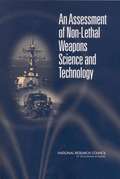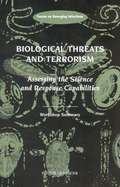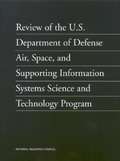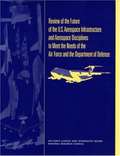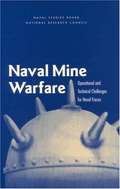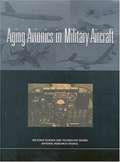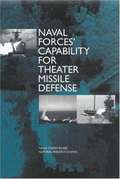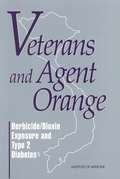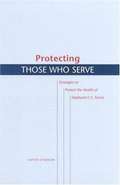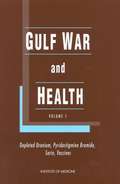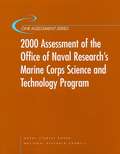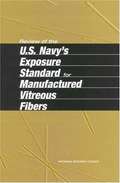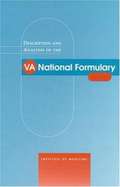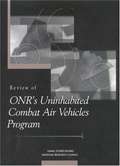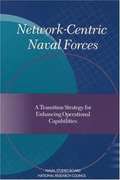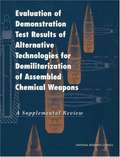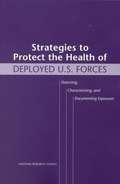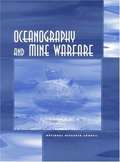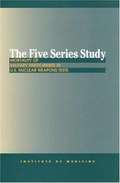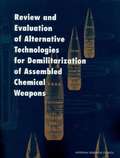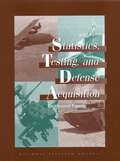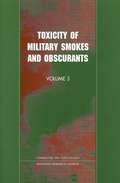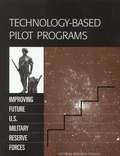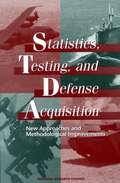- Table View
- List View
An Assessment of Non-Lethal Weapons Science and Technology
by Technology Committee for an Assessment of Non-Lethal Weapons ScienceNon-lethal weapons (NLWs) are designed to minimize fatalities and other undesired collateral damage when used. Events of the last few years including the attack on the USS Cole have raised ideas about the role NLWs can play in enhancing support to naval forces. In particular to what extent and in what areas should Department of the Navy (DoN) -sponsored science and technology (S&T) provide a research base for developing NLW capabilities? To assist with this question and to evaluate the current NLWs program, the Joint Non-Lethal Weapons Directorate (JNLWD) and the Office of Naval Research (ONR) requested the National Research Council perform an assessment of NLWs science and technology. The report presents the results of that assessment. It discusses promising NLW S&T areas, development accomplishments and concerns about NLW, and series of recommendations about future NLW development and application.
Biological Threats and Terrorism: Workshop Summary
by Leslie A. Pray Stacey L. Knobler Adel A. F. MahmoudIn the wake of September 11th and recent anthrax events, our nation's bioterrorism response capability has become an imminent priority for policymakers, researchers, public health officials, academia, and the private sector. In a three-day workshop, convened by the Institute of Medicine's Forum on Emerging Infections, experts from each of these communities came together to identify, clarify, and prioritize the next steps that need to be taken in order to prepare and strengthen bioterrorism response capabilities. From the discussions, it became clear that of utmost urgency is the need to cast the issue of a response in an appropriate framework in order to attract the attention of Congress and the public in order to garner sufficient and sustainable support for such initiatives. No matter how the issue is cast, numerous workshop participants agreed that there are many gaps in the public health infrastructure and countermeasure capabilities that must be prioritized and addressed in order to assure a rapid and effective response to another bioterrorist attack.
Review of the U.S. Department of Defense Air, Space, and Supporting Information Systems Science and Technology Program
by Technology Program Committee on Review of the U.S. Department of Defense Air Space Systems ScienceA Review of the U.S. Department of Defense Air, Space, and Supporting Information Systems Science and Technology Program
Review of the Future of the U.S. Aerospace Infrastructure and Aerospace Engineering Disciplines to Meet the Needs of the Air Force and the Department of Defense
by Committee on the Future of the U.S. Aerospace Infrastructure Aerospace Engineering Disciplines to Meet the Needs of the Air Force the Department of DefenseA Review of the Future of the U.S. Aerospace Infrastructure and Aerospace Engineering Disciplines to Meet the Needs of the Air Force and the Department of Defense
Naval Mine Warfare: Operational and Technical Challenges for Naval Forces
by Committee for Mine Warfare AssessmentA report on the Operational and Technical Challenges for Naval Forces
Aging Avionics in Military Aircraft
by National Research Council Air Force Science Technology BoardA summary of Aging Avionics in Military Aircraft
Naval Forces' Capability For Theater Missile Defense
by Institute of Medicien National Academy of Science National Academy of EnegineeringA report on the Naval Forces' Capability For Theater Missile Defense
Veterans and Agent Orange: Herbicide/Dioxin Exposure and Type 2 Diabetes
by Institute of MedicineIn response to the concerns voiced by Vietnam veterans and their families, Congress called upon the National Academy of Sciences (NAS) to review the scientific evidence on the possible health effects of exposure to Agent Orange and other herbicides. This call resulted in the creation of the first NAS Institute of Medicine Committee to Review the Health Effects in Vietnam Veterans of Exposure to Herbicides in 1992. The committee published its initial findings in the 1994 report Veterans and Agent Orange: Health Effects of Herbicides Used in Vietnam. This report is the result of a 1999 request from the Department of Veterans Affairs (DVA) under the aegis of the Veterans and Agent Orangeresearch program. Specifically, DVA asked the committee to examine evidence regarding the association, if any, between Type 2 diabetes and exposure to dioxin and other chemical compounds in herbicides used in Vietnam. Veterans and Agent Orange: Herbicide/Dioxin Exposure and Type 2 Diabetesreviews the scientific evidence regarding the association, if any, between Type 2 diabetes1 and exposure to dioxin2 and other chemical compounds in herbicides used in Vietnam. This report examines, to the extent that available data permitted meaningful determinations, (1) whether a statistical association with herbicide exposure exists, taking into account the strength of the scientific evidence and the appropriateness of the statistical and epidemiologic methods used to detect the association; (2) the increased risk of the disease among those exposed to herbicides during Vietnam service; and (3) whether there is a plausible biological mechanism or other evidence of a causal relationship between herbicide exposure and the disease.
Protecting THOSE WHO SERVE: Strategies to Protect the Health of Deployed U.S. Forces
by Committee on Strategies to Protect the Health of Deployed U.S. ForcesSince the Gulf War ended in 1991, various constituencies, including a significant number of veterans, speculate that unidentified risk factors led to chronic, medically unexplained illnesses, and these constituencies challenge the depth of the military’s commitment to protect the health of deployed troops. Despite general concurrence in findings to support these claims, few changes have been made at the field level. The most important recommendations remain unimplemented, despite the compelling rationale for urgent action. Protecting Those Who Serve illuminates these recommendations and government-developed plans that remain inactive due to a lack of authority within the Department of Defense, while describing the dangers that may result from failure to protect our forces in the field.
Gulf War and Health: Volume 1. Depleted Uranium, Sarin, Pyridostigmine Bromide, Vaccines
by Institute of MedicineMany combat troops who served in the Gulf War have suffered on-going health problems which may be linked to their wartime service. In response to the concerns of veterans and their families, the Department of Veterans Affairs contracted with the Institute of Medicine (IOM) to research possible connections between biological and chemical agents to which Gulf War veterans may have been exposed, and adverse health effects. This report presents findings from the first stage of the project, focusing on four agents: depleted uranium, pyridostigmine bromide, sarin, and vaccines. Reports on other agents will follow, in this long-term commitment to study all of the agents to which the veterans may have been exposed. Annotation c. Book News, Inc. , Portland, OR (booknews. com)
2000 Assessment of the Office of Naval Research's Marine Corps Science and Technology Program
by National Research Council Naval Studies Board Commission on Physical Sciences, Mathematics, and Applications Division on Engineering and Physical Sciences Committee for the Review of ONR's Marine Corps Science and Technology ProgramThis review of the Science and Technology (S&T) program of the Office of Naval Research's (ONR's) Expeditionary Warfare Operations Technology Division, Code 353, comes at a time of considerable change in the Marine Corps and in ONR, which are currently in the midst of significant transitions. The Marine Corps is making plans to equip and train for engaging in a new style of warfare known as Operational Maneuver From the Sea (OMFTS) and for performing a wide variety of missions in urban settings, ranging from humanitarian assistance to combat and mixes of these suggested by the term three-block war. During 1999, ONR assumed management of that portion of the Marine Corps S&T program that had not been assigned several years earlier to the Marine Corps Warfighting Laboratory (MCWL). In 2002, control of most of ONR's advanced development funding (6.3), and of much of its exploratory development funding (6.2), will move from ONR's line divisions, of which Code 353 is one of many, to 12 new program offices, each dedicated to demonstrating technologies for future naval capabilities (FNCs). Given these changes, it is not surprising that some of the projects inherited recently by ONR, and assessed by the Committee for the Review of ONR's Marine Corps Science and Technology Program under the auspices of the Naval Studies Board of the National Research Council, differed from the customary ONR project and were more akin to preacquisition or acquisition support than to S&T. It is also not surprising that Code 353 could not articulate its plans for future investments clearly and concisely, given the current uncertainty about the content of and funding level for FNCs. The Marine Corps S&T program supports the five imperatives for technology advancement that the Marine Corps Combat Development Command (MCCDC) has identified as prerequisites for the transition to OMFTS: maneuver, firepower, logistics, training and education, and command and control. The committee supports investment in these areas and, in the report's discussions and recommendations, follows the five imperatives.
Review of the U.S. Navy's Exposure Standard for Manufactured Vitreous Fibers
by Subcommittee on Manufactured Vitreous FibersThe National Academies Press (NAP)--publisher for the National Academies--publishes more than 200 books a year offering the most authoritative views, definitive information, and groundbreaking recommendations on a wide range of topics in science, engineering, and health. Our books are unique in that they are authored by the nation's leading experts in every scientific field.
Description and Analysis of the VA National Formulary
by Institute of MedicineThe National Academies Press (NAP)--publisher for the National Academies--publishes more than 200 books a year offering the most authoritative views, definitive information, and groundbreaking recommendations on a wide range of topics in science, engineering, and health. Our books are unique in that they are authored by the nation's leading experts in every scientific field.
Review of ONR's Uninhabited Combat Air Vehicles Program
by Committee for the Review of ONR's Uninhabited Combat Air Vehicles ProgramThe National Academies Press (NAP)--publisher for the National Academies--publishes more than 200 books a year offering the most authoritative views, definitive information, and groundbreaking recommendations on a wide range of topics in science, engineering, and health. Our books are unique in that they are authored by the nation's leading experts in every scientific field.
An Assessment of Undersea Weapons Science and Technology
by Technology Committee for Undersea Weapons ScienceAn Assessment of Undersea Weapons Science and Technology
Network-Centric Naval Forces: A Transition Strategy for Enhancing Operational Capabilities
by Naval Studies Board National Research CouncilInformation on Network-Centric Naval Forces
Evaluation of Demonstration Test Results of Alternative Technologies for Demilitarization of Assembled Chemical Weapons: A Supplemental Review
by National Research CouncilA review of the Evaluation of Demonstration Test Results of Alternative Technologies for Demilitarization of Assembled Chemical Weapons
Strategies to Protect the Health of Deployed U.S. Forces: Detecting, Characterizing, and Documenting Exposures
by Strategies to Protect the Health of Deployed U.S. Forces: Technology Methods For Detection Tracking of Exposures to a Subset of Harmful AgentsA report on Detecting, Characterizing, and Documenting Exposures
Oceanography And Mine Warfare
by National Research CouncilBased on a 1999 symposium, this report reviews how oceanographic data are used in US mine warfare, and the current and future capability of research to enhance such operations. Coverage includes doctrine, training issues, data collection/database capabilities, and modeling capabilities. Appends information on the symposium, a wargame scenario, the Office of Naval Research Program, and supporting research programs. Lacks an index. Annotation c. Book News, Inc. , Portland, OR (booknews. com)
The Five Series Study: MORTALITY OF MILITARY PARTICIPANTS IN U.S. NUCLEAR WEAPONS TESTS
by Institute of MedicineInformation on the Mortality of Military Participants in US Nuclear Weapons Tests
Review and Evaluation of Alternative Technologies for Demilitarization of Assembled Chemical Weapons
by National Research CouncilThe National Academies Press (NAP)--publisher for the National Academies--publishes more than 200 books a year offering the most authoritative views, definitive information, and groundbreaking recommendations on a wide range of topics in science, engineering, and health. Our books are unique in that they are authored by the nation's leading experts in every scientific field.
Statistics, Testing, and Defense Acquisition: Background Papers
by Michael L. Cohen Duane L. Steffey John E. RolphThe National Academies Press (NAP)--publisher for the National Academies--publishes more than 200 books a year offering the most authoritative views, definitive information, and groundbreaking recommendations on a wide range of topics in science, engineering, and health. Our books are unique in that they are authored by the nation's leading experts in every scientific field.
Toxicity of Military Smokes and Obscurants: Volume 3
by National Research CouncilThe National Academies Press (NAP)--publisher for the National Academies--publishes more than 200 books a year offering the most authoritative views, definitive information, and groundbreaking recommendations on a wide range of topics in science, engineering, and health. Our books are unique in that they are authored by the nation's leading experts in every scientific field.
Technology-Based Pilot Programs: Improving Future U.S. Military Reserve Forces
by National Research CouncilThe National Academies Press (NAP)--publisher for the National Academies--publishes more than 200 books a year offering the most authoritative views, definitive information, and groundbreaking recommendations on a wide range of topics in science, engineering, and health. Our books are unique in that they are authored by the nation's leading experts in every scientific field.
Statistics, Testing, and Defense Acquisition: New Approaches and Methodological Improvements
by Michael L. Cohen Duane L. Steffey John E. RolphFor every weapons system being developed, the U.S. Department of Defense (DOD) must make a critical decision: Should the system go forward to full-scale production? The answer to that question may involve not only tens of billions of dollars but also the nation's security and military capabilities. In the milestone process used by DOD to answer the basic acquisition question, one component near the end of the process is operational testing, to determine if a system meets the requirements for effectiveness and suitability in realistic battlefield settings. Problems discovered at this stage can cause significant production delays and can necessitate costly system redesign.This book examines the milestone process, as well as the DOD's entire approach to testing and evaluating defense systems. It brings to the topic of defense acquisition the application of scientific statistical principles and practices.
